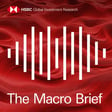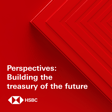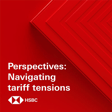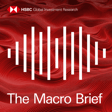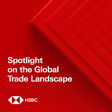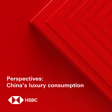Become a Creator today!Start creating today - Share your story with the world!
Start for free
00:00:00
00:00:01

The Macro Viewpoint - COP26 review, economic recovery and trade disruption
In this edition we discuss the key takeaways from the COP26 climate summit, look at what the latest data are telling us about the global economy and consider when supply chain bottlenecks could begin to ease. Disclaimer.
To stay connected and to access free to view reports and videos from HSBC Global Research click here.
Hosted on Acast. See acast.com/privacy for more information.
Transcript
Introduction to HSBC Global Viewpoint
00:00:00
Speaker
This is HSBC Global Viewpoint, your window into the thinking, trends and issues shaping global banking and markets.
00:00:09
Speaker
Join us as we hear from industry leaders and HSBC experts on the latest insights and opportunities for your business.
00:00:17
Speaker
Thank you for listening.
COP26: Outcomes and Impact on Climate Change
00:00:22
Speaker
You're listening to the HSBC Global Research Macro Viewpoint, our weekly review of the key reports from our team of economists and strategists across the globe.
00:00:34
Speaker
Coming up today, we consider the positives, negatives, and key takeaways from the COP26 climate summit.
00:00:40
Speaker
We take a look at what the latest data are telling us about the economic recovery, and we find out when trade disruption and supply chain bottlenecks could start to ease.
00:00:50
Speaker
This podcast was recorded on Thursday, the 18th of November, 2021.
00:00:54
Speaker
Our full disclosures and disclaimers can be found in the link attached to the podcast.
00:01:01
Speaker
Hello, I'm P.S.
00:01:02
Speaker
Butler.
00:01:03
Speaker
And I'm Chris Brown-Hunes.
Analyzing the Glasgow Climate Pact
00:01:04
Speaker
After two weeks of intense negotiations, COP26 due to a close on Sunday with the agreement of the Glasgow Climate Pact.
00:01:12
Speaker
Can the outcome be considered a success?
00:01:14
Speaker
Let's get the thoughts of Wei Xin Chan, head of climate change research.
00:01:17
Speaker
He spoke to Graham Mackay earlier.
00:01:19
Speaker
Weixin, welcome to the podcast.
00:01:21
Speaker
Great to have you with us.
00:01:22
Speaker
It's great to be here as always, Graham.
00:01:24
Speaker
So COP26 is now over.
00:01:26
Speaker
We've had a little bit of time to digest what went on over that couple of weeks in Glasgow.
00:01:31
Speaker
What was your overall opinion on how the summit went?
00:01:35
Speaker
It was very roller coaster for me and I think a lot of other people.
00:01:40
Speaker
But on balance, given the small wins and disappointments, I think you could say it was a modest success.
00:01:47
Speaker
A lot still to be done, ambition not there for sure, but I think climate change is a little better off after COP26 than before.
00:01:56
Speaker
All right, well, let's start on a positive note.
00:01:58
Speaker
What did you think were the plus points to come out of the summit?
00:02:02
Speaker
The first plus point is that the Paris rulebook, those are the operational guidelines of the Paris Agreement, that was completed.
00:02:09
Speaker
Now remember, this was supposed to have been done about three years ago, so we're a bit late there, but key parts of it were completed, such as Article 6 and common timeframes, and I think that's a very, very important thing to note.
00:02:25
Speaker
Secondly, I'd like to say that science was welcome again.
00:02:28
Speaker
I love making this point because...
00:02:30
Speaker
In previous COPs, under previous US administrations, science was only taken note of, whereas now that it's welcome, it means that governments will have to respond when new best available science appears, and we can expect that in early 2022.
00:02:48
Speaker
Very good.
00:02:49
Speaker
And what didn't go perhaps so well?
00:02:52
Speaker
There's always a lot of things that don't go well and certainly not to the extent that a lot of parties are looking for.
00:02:59
Speaker
The first would have to be finance.
00:03:02
Speaker
Definitely developed countries miss their 2020 target and they're now promising for 2022 or 2023.
00:03:10
Speaker
We didn't get enough financial commitments on adaptation finance and certainly not enough for loss and damage.
00:03:17
Speaker
They are talking a lot more about the definitions of finance, which I think is a good thing, especially for climate finance, and also bringing concessional finance into play.
00:03:26
Speaker
This is about low interest rate loans, grants, guarantees.
00:03:30
Speaker
and other de-risking instruments, which I think is important because that is what countries that are most vulnerable to climate change really need.
00:03:37
Speaker
They can't be spending their time repaying interest loans.
00:03:40
Speaker
They really need to be working on how they can adapt their economies to be more resilient.
00:03:45
Speaker
Now, at the end of the day, all of this fundamentally comes down to global temperatures.
Post-COP26 Temperature Projections and Pledges
00:03:49
Speaker
How are things looking in that regard?
00:03:51
Speaker
We're often asked to judge these things by where temperatures are heading.
00:03:55
Speaker
And for this one, the temperature projections for the future have come down a little modestly from where it was before COP26 at 2.7 degrees to...
00:04:06
Speaker
if all the pledges and policies made at COP26 are implemented, we're now heading for 2.4 degrees.
00:04:11
Speaker
Now, that is way off the mark from 2 degrees and certainly the 1.5 degrees that we're looking for.
00:04:17
Speaker
So definitely a lot of work to be done.
00:04:20
Speaker
Now, to end on a positive note, countries have been asked to come back next year with even more ambitious climate pledges and plans.
00:04:29
Speaker
Now, that's very important because this was only supposed to happen every five years.
00:04:34
Speaker
But to come back next year and say,
00:04:36
Speaker
we need to keep bending this curve.
00:04:37
Speaker
We got from 2.7 to 2.4.
00:04:39
Speaker
Can we nudge it down even further next year?
00:04:41
Speaker
So I think countries bringing more ambitious climate pledges to the table by the end of 2022 is a great way to take forward.
00:04:50
Speaker
And are you confident that that trajectory can be sustained and that we're still on the right track and will remain so for the foreseeable future?
00:04:59
Speaker
I think we'll be shaving off 0.1s of degrees as we go along.
00:05:05
Speaker
It's not nearly enough that we need to get to 1.5 degrees.
00:05:09
Speaker
The world is already warm by 1.1 degrees and we see all these extreme events already around the world and that's devastating for many, many places.
00:05:18
Speaker
But we need to try a lot harder and I think that's a step in the right direction at least.
00:05:22
Speaker
Good.
00:05:23
Speaker
Well, we'll take the positives or we can get them.
00:05:24
Speaker
Wei Xin-Chan, thank you very much.
00:05:26
Speaker
Thank you very much, Graham.
00:05:30
Speaker
Let's turn our attention to the economic
COVID-19's Mixed Impact on Economies
00:05:32
Speaker
recovery now.
00:05:32
Speaker
James Pomeroy, global economist, has been looking through the latest data and he joins me now.
00:05:38
Speaker
James, welcome to the podcast.
00:05:40
Speaker
Hi, pleasure to be here.
00:05:41
Speaker
James, let's start with a look at COVID-19.
00:05:44
Speaker
What's the latest on case numbers?
00:05:46
Speaker
So there's a really mixed story across the world.
00:05:48
Speaker
We've got the case numbers that are picking up relatively quickly in parts of Europe and some restrictions starting to come in place in some countries.
00:05:56
Speaker
But actually across the world, things are looking slightly better outside of Europe, particularly in Asia.
00:06:01
Speaker
And we've seen case numbers drop quite sharply, particularly given where we were in the summer, particularly in the likes of ASEAN.
00:06:07
Speaker
So things are looking slightly better on a global basis if we look outside of Europe.
00:06:11
Speaker
But in Europe, we're seeing this pick up in cases and some of these restrictions coming back into place.
00:06:16
Speaker
And it appears that consumer spending is showing no signs of slowing down.
00:06:20
Speaker
Not really, no.
00:06:21
Speaker
If we look at the data across the US and across Europe, which are good barometers of economies that have pretty much opened up, consumers' demand is still really, really robust, both for services and for goods.
00:06:31
Speaker
And it appears that demand is being held back by some of the shortages we're seeing from bottlenecks in the supply chain, as well as shortages in the labour market too.
00:06:42
Speaker
Now, you mentioned labour markets there.
00:06:44
Speaker
What are the data showing?
00:06:46
Speaker
So it's a really odd one where if you looked at the unemployment rates across the world, it would look like we've got very, very loose labour markets.
00:06:51
Speaker
But if you look at different data such as job openings, you start looking at the availability of workers, the wage growth figures, the quits rates, all of these other sort of sub forecasts and sub indicators that we'd look at, really, you do get a really tight labour market.
00:07:08
Speaker
You've got people quitting jobs at record rates.
00:07:10
Speaker
You've got wage growth in certain sectors picking up at record rates.
00:07:14
Speaker
So it's a really odd one in terms of trying to assess how strong labour markets are.
00:07:18
Speaker
But across that mix of data, it's quite easy to tell a story of very, very tight labour markets where companies are struggling to get hold of enough workers.
00:07:26
Speaker
And how is all of this affecting inflation?
00:07:29
Speaker
Well, it's meaning inflation's up and it's likely to stay high at least for the next six months or so.
00:07:34
Speaker
If you think about these bottlenecks in supply chains, they're pushing up goods prices, shortage of workers pushing up wages.
00:07:40
Speaker
That means companies are seeing higher input costs.
00:07:42
Speaker
All of this is a bit of a challenge in terms of those inflation prints because there's a lot of these factors that are clearly pushing up prices on top of the increases in energy prices that we've seen too.
00:07:55
Speaker
So firms are facing this
00:07:56
Speaker
really challenging environment of input costs rising really, really quickly.
00:08:00
Speaker
And some of that's being passed on.
00:08:02
Speaker
More of it could be passed on in 2022.
00:08:05
Speaker
How much of that is passed on is going to be a key determinant of the inflation sort of profile, I guess, across the world in the coming year.
00:08:13
Speaker
How are central banks reacting?
00:08:14
Speaker
Well, this is a tricky environment for them because if you've got high inflation today, you've got relatively strong demand.
00:08:20
Speaker
You've also got high house prices in most of the world.
00:08:22
Speaker
You think you could be tightening policy.
00:08:25
Speaker
But a lot of central banks are sat there sort of being quite conservative and saying, well, actually, some of this inflation is going to dissipate.
00:08:32
Speaker
A lot of it is sort of one off shocks and factors that aren't going to be repeated.
00:08:35
Speaker
in 12 months time and therefore we shouldn't do much.
00:08:38
Speaker
And so you've got one extreme, you've got central banks in Latin America and in Central and Eastern Europe who are raising rates quite aggressively.
00:08:45
Speaker
You've got Norway and New Zealand who have already raised rates in the developed world.
00:08:48
Speaker
Then the other end of the spectrum, you've got the likes of the ECB, Sweden's Riksbank, Australia's RBA, all very, very comfortable and we're not doing anything in terms of raising interest rates.
00:08:59
Speaker
That's a great summary, James.
00:09:00
Speaker
Thanks very much.
00:09:01
Speaker
Thanks very much.
00:09:05
Speaker
James mentioned the impact of supply chain bottlenecks there.
00:09:08
Speaker
And a key question for businesses all around the globe is when they might come to an
Trade Disruptions and Supply Chain Issues
00:09:12
Speaker
end.
00:09:12
Speaker
To find out, we're joined by Shanela Rajanayagam, our trade economist, who this week joined up with our data science team to examine this important topic.
00:09:21
Speaker
So Shanela, can you just explain what you looked at in this report?
00:09:24
Speaker
Sure.
00:09:24
Speaker
So to get a sense of what businesses have been saying about trade disruption, we looked at data from recent company earnings calls as well as from business surveys.
00:09:36
Speaker
So in addition to actually reading the transcripts, our data science team used natural language processing to analyze what companies have been saying around certain topics, such as supply
00:09:47
Speaker
shortages and shipping disruptions, and also to get a sense of how companies are feeling, so their sentiment about some of these issues.
00:09:57
Speaker
So what have businesses been saying about these issues?
00:09:59
Speaker
So companies from around the world have been very concerned about supply shortages, and this issue featured most prominently for companies in the technology, industrials, and consumer goods sectors.
00:10:12
Speaker
Companies in Europe and the US were also particularly concerned about shipping disruptions and higher freight costs and supply shortages were weighing on company sentiment on supply chains.
00:10:24
Speaker
In the UK, many companies talked about the combination of COVID-19 and Brexit, and this has increased their concerns around trade disruption.
00:10:34
Speaker
And in fact, according to one survey, around 85% of UK businesses reported facing some form of supply chain disruption over the past three months.
00:10:44
Speaker
And what measures are companies taking to limit the disruption?
00:10:47
Speaker
Details from the earnings calls showed that companies have taken various strategies to essentially ensure that their goods keep moving.
00:10:55
Speaker
For example, you have companies like Crocs and Levi's.
00:10:59
Speaker
They've looked to shift production to alternative markets or to redirect trade to different routes.
00:11:05
Speaker
You also have the likes of Electrolux and ASOS.
00:11:08
Speaker
They've looked to use alternative modes of freight, such as air freight, while various manufacturers have also looked to build up buffer stocks.
00:11:16
Speaker
There was also a strong emphasis on strengthening relationships with suppliers.
00:11:21
Speaker
And some companies have also looked to source closer to home, although nearshoring is a bit more of a longer term trend.
00:11:29
Speaker
There were also some mentions about looking at vertical integration and helping these companies to secure their supply chain.
00:11:37
Speaker
And when exactly will these trade disruptions start to ease?
00:11:41
Speaker
Well, it is very difficult to answer that question precisely, and it will almost entirely depend on COVID-19 restrictions and also the strength of global goods demand.
00:11:52
Speaker
However, one scenario is that trade disruption could start to ease after the Lunar New Year in February 2022.
00:11:59
Speaker
Now, the period after Lunar New Year tends to be a quieter one for sea freight anyway, and the temporary closure of Chinese factories could provide some breathing room for ports to clear those container backlogs without even greater supply coming from China.
00:12:16
Speaker
However, there is a risk that two weeks' respite might not be enough to fully unclog the bottlenecks.
00:12:22
Speaker
And so in a second scenario, we could see trade disruptions only start to ease in the second half of next year.
00:12:30
Speaker
And that could be if container volumes remain high or if COVID-19 restrictions persist.
00:12:36
Speaker
What about the worst case scenario?
00:12:38
Speaker
So there is a risk that disruptions could not ease next year.
00:12:42
Speaker
And in this case, perhaps more stringent COVID restrictions have been imposed.
00:12:47
Speaker
There could also be the risk of ongoing closures of certain port terminals or factory operations, and also issues around land side logistics could persist.
00:12:58
Speaker
There's also the issue of upcoming negotiations at
00:13:02
Speaker
US West Coast ports between the port operator and the labor union, which could also lead to further disruption in the second half of next year.
00:13:11
Speaker
But however, I think the point to note is that regardless of which three of these scenarios play out, even once trade disruptions do start to ease, it is likely that it will take months for supply chains to fully disentangle.
00:13:25
Speaker
Shanela, thanks very much for your time.
00:13:28
Speaker
Thank you.
00:13:31
Speaker
So that's all from us today.
00:13:32
Speaker
Thank you to Weishin Chan, James Pomeroy and Shanela Rajanagam for joining us.
00:13:38
Speaker
From all of us here, thanks for listening.
00:13:40
Speaker
We'll be back again next week.
00:13:46
Speaker
Thank you for listening today.
00:13:48
Speaker
This has been HSBC Global Viewpoint, Banking and Markets.
00:13:52
Speaker
For more information about anything you heard in this podcast or to learn about HSBC's global services and offerings, please visit gbm.hsbc.com.
